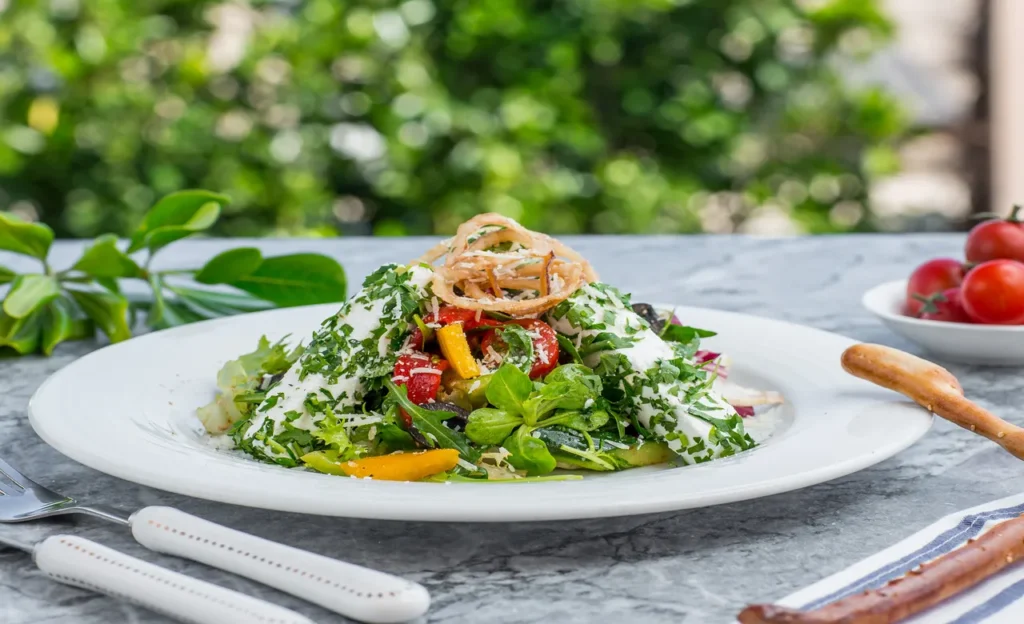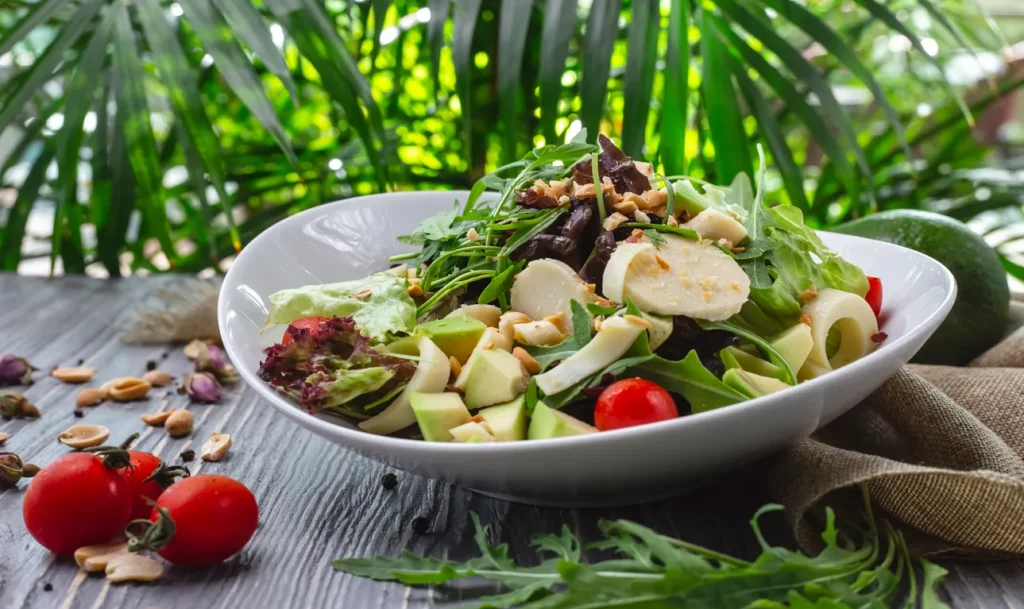That diet where everyone is happy, healthy, and lives to 100? Mediterranean diet it got greener. The green diet emphasizes plant-based cuisine, minimal meat, and sustainable seafood. Fresh, local, and seasonal foods are celebrated in this diet. The green Mediterranean diet may help you feel invigorated, healthier, and more environmentally friendly.
This diet emphasizes genuine food over fads and packaged snacks. Fruits, vegetables, whole grains, legumes, nuts, and olive oil. Moderate meat and dairy. Two times a week, eat sustainable seafood. This balanced approach has endured the test of time and is now eco-friendly. Ready to eat healthier and greener? Learn how from the green Mediterranean diet. Fresh, healthful, and sustainable—what’s not to like? This post explains everything you need to start.
Benefits of Following a Green Mediterranean Diet
A diet green Mediterranean improves your health and the environment. Plant-based whole foods benefit your body and the environment.
Improved Health
A green diet emphasizes plant-based foods such as fruits, vegetables, whole grains, legumes, nuts, and seeds. These superfoods contain fiber, antioxidants, and plant components that lower the risk of heart disease, type 2 diabetes, and several cancers.
Reduce bad fats, sugar, and preservatives by reducing red meat and processed meals. Beans, lentils, and tofu are plant-based protein sources for weight loss and lifespan. Heart, waistline, and longevity will benefit.
Environmental Sustainability
One of the best strategies to reduce carbon emissions is to eat more veggies and less meat. Meat production deforests, pollutes, and emits greenhouse gases. Plant foods need less land, water, crops, and fossil fuels.
Instead of eating meat, a Mediterranean diet can reduce carbon dioxide emissions by hundreds of pounds each year. Your actions help future generations by supporting sustainable food systems and a better planet.
Community Connection
The Mediterranean culture emphasizes food socialization. Cooking with friends and family, eating together, and buying local vegetables build community.
Following this diet, you may connect more with your food and its growers. Farmers markets, CSAs, and local gardens may interest you. Sharing tasty, home-cooked, plant-based meals strengthens connections and improves health.
The Mediterranean diet nurtures body and spirit. Focusing on fresh, healthy meals and table delights will make you happier, healthier, and more sustainable.
Foods to Eat on the Mediterranean Diet

The green Mediterranean diet focuses on fresh, whole foods like fruits and vegetables, whole grains, legumes, nuts, and seeds. Some of the staples to incorporate into your diet include:
Leafy Greens
Spinach, kale, swiss chard, and romaine lettuce are all healthy options. Aim for 2-3 cups a week. Leafy greens provide vitamins A, C, and K and antioxidants.
Cruciferous Vegetables
Vegetables like broccoli, cauliflower, and Brussels sprouts contain compounds that may help fight cancer. Try roasting or steaming 1-2 cups a few times a week.
Alliums
Onions, garlic, shallots, and leeks add flavor to dishes. They contain antioxidants and compounds that may help lower inflammation in the body. Use it liberally in cooking or add raw ingredients to salads and sandwiches.
Fruits
Focus on fruits high in antioxidants like berries, citrus fruits, melons, and stone fruits. Berries, in particular, such as blueberries, raspberries, and strawberries, contain anthocyanins, giving them their bright red and blue hues. Aim for 2-3 cups of fruit per day.
Whole Grains
Choose whole wheat bread, pasta, brown rice, farro, quinoa, and oats. Whole grains provide fiber, B vitamins, and minerals. Aim for 3-5 servings a day.
Legumes
Beans, lentils, and chickpeas are excellent fiber, protein, iron, and magnesium sources. Add 1/2 to 1 cup of cooked legumes to your diet 3-4 times weekly. Options include black beans, kidney beans, lentil soup, or hummus.
Nuts and Seeds
Almonds, walnuts, pistachios, pumpkin seeds, and chia seeds contain healthy fats, protein, and fiber. Enjoy 1 to 2 ounces of nuts or 2 to 3 tablespoons of seeds daily. Add to yogurt or salads or enjoy as a snack.
Olive Oil
Olive oil is a key component of the Mediterranean diet. It is high in heart-healthy monounsaturated fats. Use for cooking, baking, and salad dressings instead of other vegetable oils. Aim for 2-3 tablespoons per day.
Sample Meal Plan for Mediterranean Diet

The Green diet emphasizes fresh fruit, whole grains, legumes, nuts, and healthy fats. Start with this sample food plan:
Breakfast
Cooked oatmeal with 1/2 cup fresh berries, 2 tablespoons chopped nuts, honey drizzle, 1 cup unsweetened almond milk, 1/2 grapefruit
Lunch
Mixed greens salad with cucumbers, tomatoes, chickpeas, and olive oil lemon vinaigrette. Whole wheat pita bread, hummus for dipping, -1/2 cup plain Greek yogurt with 1/2 cup fresh fruit
Dinner
-1 cup cooked whole wheat pasta -2 cups sautéed zucchini, bell peppers, and spinach with garlic and olive oil -1/2 cup cooked lentils -2 teaspoons grated Parmesan Lemony-steamed broccoli
To snack
1-ounce almonds or walnuts – 2 tablespoons olive tapenade with vegetable sticks -1 cup fresh or frozen berries with coconut cream whipped topping
The emphasis is on plant-based foods such as vegetables, fruits, whole grains, legumes, nuts, and olive oil. Meat, poultry, and fish are allowed twice a week. Red meat and sweets are limited. This balanced diet with fresh, less processed products includes antioxidants, fiber, healthy fats, and vitamins and minerals for health and longevity. This meal plan helps you start eating fresher and greener.
Tips for Transitioning to the Green Mediterranean Diet
The Green diet transition is easier than you think. Here are some starting tips:
Begin with little modifications
Do not change your diet overnight. Slowly incorporate more plant-based and healthy foods into your diet. Have a salad for supper three evenings a week or roasted veggies instead of fries. Once chronic, make another tiny modification. Sustainable transformations are slow and steady.
Focus on fresh produce
This diet emphasizes fresh produce, healthy grains, and legumes. Half your plate should contain spinach, tomatoes, cucumbers, peppers, broccoli, carrots, berries, and citrus at each meal. Buy seasonal and local produce wherever feasible.
Cook more at home.
Home cooking with fresh ingredients is crucial. Eat less out and pre-made meals, which are heavy in salt, sugar, harmful fats, and poor nutrition. Use olive oil and fresh herbs and spices to flavor home-cooked dishes. Socialize and enjoy cooking with friends and family.
Select healthy fats
The Green Mediterranean diet recommends using olive oil, almonds, and avocados for fat. Cook and season salads with olive oil. Snack on almonds, walnuts, or pistachios. Mash half an avocado on toast or chunk it in a salad. Limit saturated-fat red meat and full-fat dairy.
Stay hydrated and drink wine moderately!
Hydrate to assist digestion and nutrition absorption. Drink red wine with your meal occasionally—one per day for ladies and two for males. Moderate red wine consumption may improve heart health due to antioxidants.
Conclusion
This is a guide to eating fresh, green Mediterranean style. Your tasty diet features seasonal fruit, whole grains, and fresh fish. Salads, soups, and stews full of vegetables, herbs, and olive oil make you feel good about eating. Most importantly, the green Mediterranean diet includes local, organic products, making it sustainable and ecologically beneficial. Try this new spin on a classic dish. The world and your taste buds will thank you. Eat well! Our Services include the best healthy eating habits, nutrition guides, diet, nutrition plans and newsdailytime..
Also Read: 5 Mediterranean Diet for Fatty Liver

